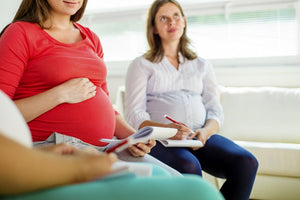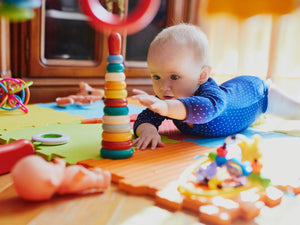In my practice as a clinical psychologist, parents often say to me that there’s nothing they can do to help their crying baby. While you may not be able to stop the crying, there are absolutely things you can do – things to help your baby feel safe and reassured.
Sometimes babies feel frightened, overwhelmed and out of control. It can be distressing for them to feel such powerful emotions when they are only beginning to experience the world. It can also be distressing for you to witness their distress – it is hard not to be affected by it. At these times, you are able to help your baby get her sense of meaning and contain her distress when you identify and reflect on her emotional state. Thinking about her experience provides containment and helps a baby feel safe. Of course, your baby will also need you to soothe her by holding her close, swaddling her, speaking gently with her, rocking her and any other strategies that work to calm her. But in all of these actions, an attempt to reflect on her experience and empathise can be felt by her as containing. Your efforts to ease the crying may not bring about a consoled baby – she may remain distressed. At these times, your understanding and hanging in there with her can be very reassuring, even when she remains distressed. At these times, she will experience that you do not leave her alone to deal with her difficult feelings.
When our anxieties are contained we feel comforted, reassured. Being contained by another gives us the experience of being held together when we might otherwise fall apart.
Tolerating your baby’s distressing feelings, as well as your own, helps her cope. If she repeatedly experiences your ability to identify with her distress and to tolerate it, she comes to learn that distress can be tolerated. Containing her this way helps her learn to contain and soothe herself over time. She learns that it is possible to tolerate the distress she is experiencing which helps her feel safe. She learns that bad feelings pass and good feelings can return. Leaving yourself as open as possible to understand what she is communicating and then responding appropriately gives your baby the experience of being understood and comforted. This is containing for her.
The following two examples show how parents can use themselves to contain their baby’s distress.
Simon used physical holding and his words to contain four-week old Bethany’s distress. She was protesting and grizzling, which Simon immediately attributed to hunger, as he knew she was due for a feed. Simon moved from the couch to the kitchen with Bethany in his arms. He removed a bottle from the fridge, heated the kettle and warmed the bottled milk in a container of hot water. He tested the temperature of the milk on his wrist and moved into the lounge back to the couch. He kept Bethany in his arms the entire time, balancing her from arm to arm when he needed to move or do other things. Her protest became a more intense cry. Simon empathised saying, “Sorry little one, I know you’re hungry, it’s coming, it’s coming. I should have started to warm your milk earlier. I forget that it takes time. You’re ok.” Simon’s tone was reassuring, calming, containing. He could feel Bethany’s distress but he was not overwhelmed by it. His tone of voice conveyed his concern for Bethany’s discomfort in waiting.
Eight-week old Reilly screams out in pain when feeding in the late afternoon and evening. He has stomach pain from wind. His mother Sarah often feels helpless that she cannot alleviate his physical pain. Reilly stiffens his whole body, screams out and goes red in the face. Sarah holds him close and speaks softly to him, reassuring him – “It’s okay, I know it hurts, it will pass”. When his distress continues she tries different things – walking around or putting him in the freestanding baby rocker. When she becomes overwhelmed by his distress and becomes upset herself, Sarah finds the rocker helps both of them – she recognises that she is not always a calming influence for Reilly, even though she wants to be. While Sarah may not physically hold Reilly to contain him, she finds a way to de-escalate their franticness and upset through separation but remaining in close proximity. Sarah stays close by Reilly, keeps her mind wrapped around his experience and when she has calmed she regains her reassuring tone with him that all will be well in time.
In these examples both parents used their capacity to reflect on their baby’s experience to try to understand what their baby was feeling and why. In both illustrations the parents stayed with their babies and tolerated their distress without leaving them alone. They held them physically and psychologically by having their minds wrapped around them. Both parents conveyed empathy and the firm belief that their infant would recover from their temporary discomfort.
Wrap your mind around your baby’s experience like a blanket – it holds her together like a second skin…
It is a big ask to be able to do this while staying mindful of your own emotional state and without feeling overwhelmed and chaotic yourself. Doing your best to remain calm can be a challenge that you don’t always manage. It is realistic to assume you will not always be able to do this for your baby or yourself. What you can ask of yourself is that you do your best to respond to her needs as responsively and appropriately as you can manage at that time.
Your baby’s distress can be contained through empathy, thinking about his internal world and tolerating his experience. Being with him in his scary feelings means he doesn’t have to be alone with them. He comes to trust you will be there to help even if you can’t take away the pain.
About the Author
Dr Bronwyn Leigh is a clinical psychologist, perinatal and infant clinician and early parenting consultant. Bronwyn co-authored the evidence-based self-help book Towards Parenthood: Preparing for the Changes and Challenges of a New Baby (ACER Press, 2009). She is the Director of the Centre for Perinatal Psychology, a national network of psychologists specialising in the emotional wellbeing of parents and infants before and during pregnancy, and the three years following the birth of a baby. To find your nearest perinatal psychologist visit www.centreforperinatalpsychology.com.au
Our Products
-

01. Guide to a Healthy Pregnancy
$55 -

02. Positive Birthing Course
$55 -

03. Infant Feeding Guide
$55 -

04. Baby Sleep Guide - First 12 Months
$55 -

05. Toddler Parenting Course 1 - 3 Years
$55
-
 When to Start Antenatal Classes?
When to Start Antenatal Classes?
Becoming a parent is an incredible milestone, but it comes with a host of changes that can be daunting, especially for first time parents. Antenatal classes are all about offering expectant parents the education they need to make informed decisions, look after their bodies and care for their newborn babies. While you probably already have a long list of things you need to accomplish during your pregnancy, it’s a good idea to make time to attend antenatal classes.
-
 Development Milestones 4-8 Months
Development Milestones 4-8 Months
As they reach the middle of their first year, you'll start to see bigger leaps in their growth and ability!
In this article, we’re going to discuss your baby’s developmental milestones between 4-8 months, and what you can expect along the way.





 When to Start Antenatal Classes?
When to Start Antenatal Classes?
 Development Milestones 4-8 Months
Development Milestones 4-8 Months








